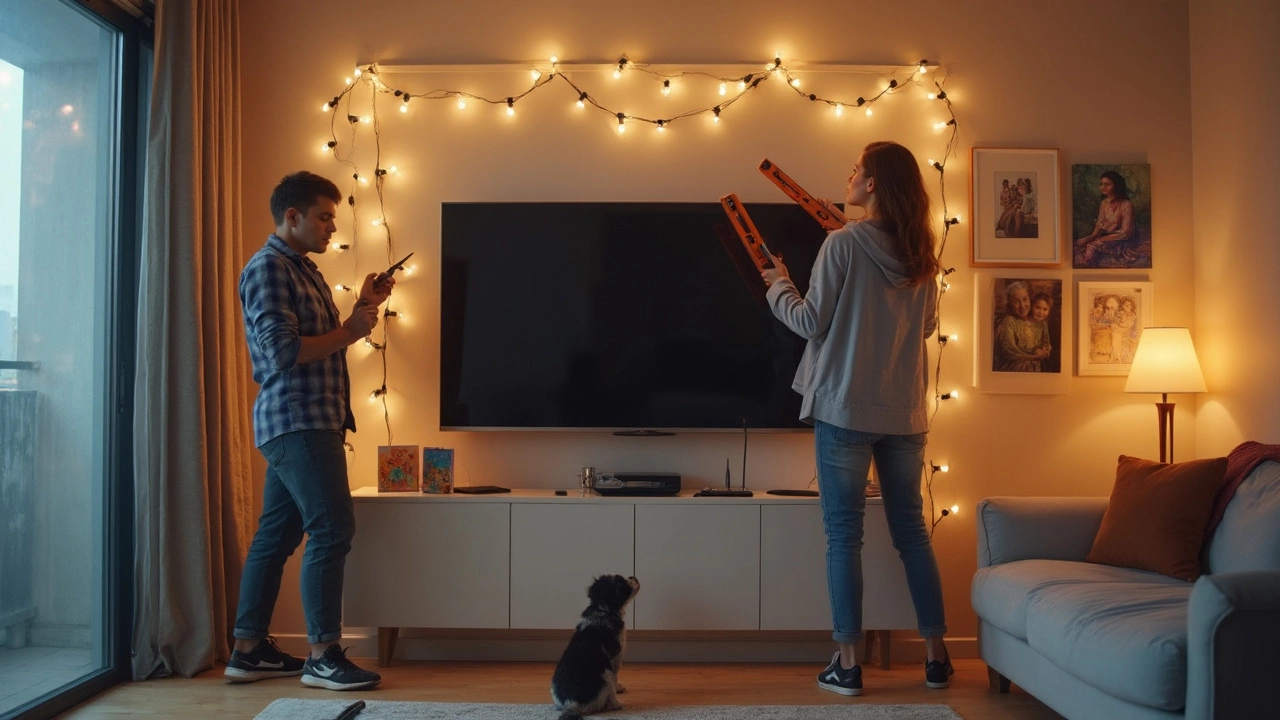So you just unpacked a TV—or maybe your old stand broke—and you’re staring at a shiny screen with nothing to sit it on. Happens way more often than you’d think. Most newer TVs are sold with mounting in mind, not big, blocky stands like in the old days. And when stands do break or disappear, replacement parts can take forever to ship—if you find them at all.
Blocking your TV on a pile of books or balancing it on a too-small table might sound harmless, but it’s actually a recipe for disaster. With how top-heavy modern flatscreens are, you’re risking a wobbly mess or an expensive drop the second someone bumps the setup. Safe and solid placement is the name of the game if you care about your TV—and maybe your toes.
The good news? There are some easy fixes. From simple wall mounting to quick DIY stands and a couple of rental-shop hacks, you’ve got more options than you’d guess. Let’s figure out what you can do—without waiting weeks or breaking the bank.
- Why Your TV Has No Stand
- The Wall Mount Approach
- DIY Fixes and Safe Hacks
- TV Placement Mistakes to Avoid
Why Your TV Has No Stand
If you’ve ever pulled a brand-new TV out of the box and wondered where the heck the stand went, you’re not alone. A lot of today’s TVs don’t even come with an included base. This isn’t some kind of packaging error—it’s a shift in how people use TVs, and manufacturers are cutting costs wherever they can.
About 60% of TV buyers in 2024 chose to wall mount their screens, according to a recent Consumer Tech Association survey. Since wall mounting is so popular now, some brands ditch stands altogether or sell them separately to keep the main box lighter and smaller. Less packaging and fewer plastics are better for shipping and, according to brands, the environment. But for buyers, it can be a surprise.
Replacement stands for name brands can be a pain to track down. Some TVs come off the curb, some are hand-me-downs, and some just outlive their original hardware. If you grabbed yours during a Black Friday blitz for half what it’s worth, there’s also a good shot it was a "display model" and never had a stand included to start with.
| Reason for Missing Stand | Frequency (%) |
|---|---|
| TV is designed for wall mounting | 45% |
| Stand sold separately to reduce box size/weight | 30% |
| Lost or broken stand | 15% |
| Second-hand or display model | 10% |
If you search for a TV stand that matches your exact model, it can sometimes cost nearly as much as a small table. So, figuring out another way to keep your TV safe and level often makes a lot more sense than hunting for official parts you'll probably overpay for and wait weeks to get.
The Wall Mount Approach
Wall mounting is the most popular backup plan if your TV doesn’t have a stand—and honestly, it’s often the safest and cleanest-looking choice. Most modern TVs (especially ones made after 2016) support the VESA mounting standard. This just means you’ll see four threaded holes on the back of your TV, spaced in a square or rectangle pattern. That’s your built-in ticket for slapping your TV on the wall.
Mounts range from fifteen bucks for basic brackets at stores like Walmart to swanky, fully-articulating arms that let you tilt and swivel your screen every which way. Just make sure to check two things: the size range and weight limit of the mount, and whether it matches your TV’s VESA pattern (like 100x100mm or 400x400mm). Most manufacturers list these numbers clearly in their manual or on their website.
Here’s what you’ll need if you’re going the wall-mount route:
- A stud finder (because drywall alone will not hold your TV—it’ll come crashing down)
- A drill and the right bit size
- Screws and wall anchors (usually included with the mount kit, but double-check—sometimes you need to use bigger anchors for heavier TVs)
- A level for making sure your TV doesn’t look tipsy
- Someone to help you lift and position the TV; even a 55-inch flat screen is clunky and fragile
People worry that mounting will ruin their walls. Not if you do it right. Use a stud finder to hit real wood, not just drywall—each wood stud can support up to 80 pounds, sometimes more. Here’s a quick cheat sheet with typical TV weights and recommended wall mount types:
| TV Size | Average Weight | Bracket Type |
|---|---|---|
| 32" | 10-15 lbs | Basic / Tilt |
| 50" | 25-35 lbs | Tilt / Full Motion |
| 65" | 45-55 lbs | Full Motion |
| 75"+ | 70-90 lbs | Heavy Duty |
Here’s a big tip: Don’t eyeball the height. For ideal viewing, the center of your TV should line up with where your eyes naturally sit while you’re on your couch. That’s usually about 42 inches from the floor for most living rooms.
Got old plaster or brick walls? You can still mount, but use masonry anchors or special toggle bolts. Double-check your wall type before drilling—nothing ruins your day like a hole in crumbling plaster.
Wall mounting sounds harder than it is, but if tools make you nervous or you don’t want to risk it, big box stores and even Amazon offer installation for under $100. Worth it if you’re worried about accidentally turning your living room into a construction site. For renters, there are even "no-drill" mounting solutions that clamp to furniture, though these max out with smaller, lighter TVs.
No matter how you do it, a tidy, wall-mounted TV setup not only saves space but sidesteps all the safety risks of a teetering flatscreen. And if you ever move, patching some tiny mounting holes is way less hassle than replacing a shattered TV.
Looking for a TV stand alternative that keeps things sleek and secure? Wall mounting is usually the move.

DIY Fixes and Safe Hacks
If you don't have a TV stand, don't stress. You can put together some solid solutions without spending much or waiting weeks for delivery. These fixes don't require pro skills. Think of them like quick home improvement projects you can actually finish in one afternoon.
- Repurpose furniture. That old low dresser or a sturdy coffee table can work as a base for most TVs. Just make sure whatever you use is wider than the TV’s stand holes and sits flat, not wobbly. People love using IKEA KALLAX shelves—they’re cheap and handle weight well.
- DIY plywood base. Grab a thick piece of plywood, cut it a bit wider than the TV, and add stick-on rubber feet underneath for grip. Set your TV on top, making sure it’s centered and nothing overhangs. For extra safety, add adhesive bumpers on the edges to prevent sliding. Cheap, sturdy, and looks better than balancing it on a cardboard box.
- VESA adapter hack. If your TV still has the screw holes in the back (called VESA mounts), you can grab a universal tabletop TV stand online. These usually run $20–$30 and let you bolt the legs right into the TV. They fit most brands and don't take up much room.
- Wall shelf solution. A heavy-duty floating shelf is another way out. Look for shelves rated to hold at least 50 pounds. Mount them straight into studs, not just drywall, to avoid a crash landing. Place the TV on top and route cables through the wall for a clean look.
If you’re a stats nerd, check out the average weight and stand widths of modern TVs—handy for picking the right hack:
| TV Size | Average Weight (lbs) | Recommended Base Width (inches) |
|---|---|---|
| 32" | 9 | 28+ |
| 43" | 15 | 38+ |
| 55" | 24 | 48+ |
| 65" | 40 | 58+ |
Last tip: always use anti-tip straps if you’ve got kids or pets around. They cost less than a pizza and keep everyone (and your TV) way safer. The idea is simple: anchor one end to the TV, the other end to the wall or furniture behind it. Not fancy, but it works.
TV Placement Mistakes to Avoid
It’s easier than you think to mess up your TV setup when you don’t have a proper stand. Trust me, it’s not all about what looks good—safety and function come first. Here are the most common mistakes people make, and how you can dodge them.
- Putting the TV on furniture that's too small: Don't try to balance your TV on a nightstand, tiny table, or anything narrower than your screen. If the base wobbles even a little, that’s a bad sign. A 2022 report from the Consumer Product Safety Commission showed that over 16,000 injuries in the U.S. were linked to TV tip-overs. Most of those could've been avoided with stable placement.
- Ignoring weight limits: Not every piece of furniture is built for a heavy flatscreen. Check your TV's weight and make sure your coffee table, shelf, or whatever you're using can actually handle it. Manufacturers usually list safe weight limits on furniture labels or websites.
- Leaving the TV unsecured: TVs should be anchored—even if they’re just sitting on furniture. Anti-tip straps or simple wall tethers are cheap, easy to use, and can stop your TV from sliding or falling if someone bumps it. Also, don’t leave cords dangling—kids and pets love to tug on stuff.
- Using books or random objects as makeshift stands: Stacking your TV on books, boxes, or old game consoles seems clever, but it’s risky. These items easily shift and break, plus they rarely give a flat, even surface.
- Setting the TV too high or low: If you need to crane your neck or tilt your head down while watching, you’re setting yourself up for a stiff neck or headaches. The sweet spot? The center of your *TV screen* should be around eye level when you're sitting.
Here's a quick table so you can spot the top risks at a glance:
| Mistake | Common Result | How to Avoid |
|---|---|---|
| TV on too-small surface | Wobbles/tip-overs | Choose a wide, stable platform |
| Overloading furniture | Furniture collapse | Match weight limits |
| No anchor/tether | TV slides or falls | Install anti-tip devices |
| Makeshift stands (books, boxes) | Instability & unevenness | Use level, solid surfaces only |
| Poor height placement | Neck strain | Center TV at eye level |
As simple as it sounds, a safe TV stand or a wall mount fixes almost every one of these problems. If you cut corners, you risk your TV, and maybe a visit to the ER. Play it safe—your screen (and your health) is worth a little effort.

